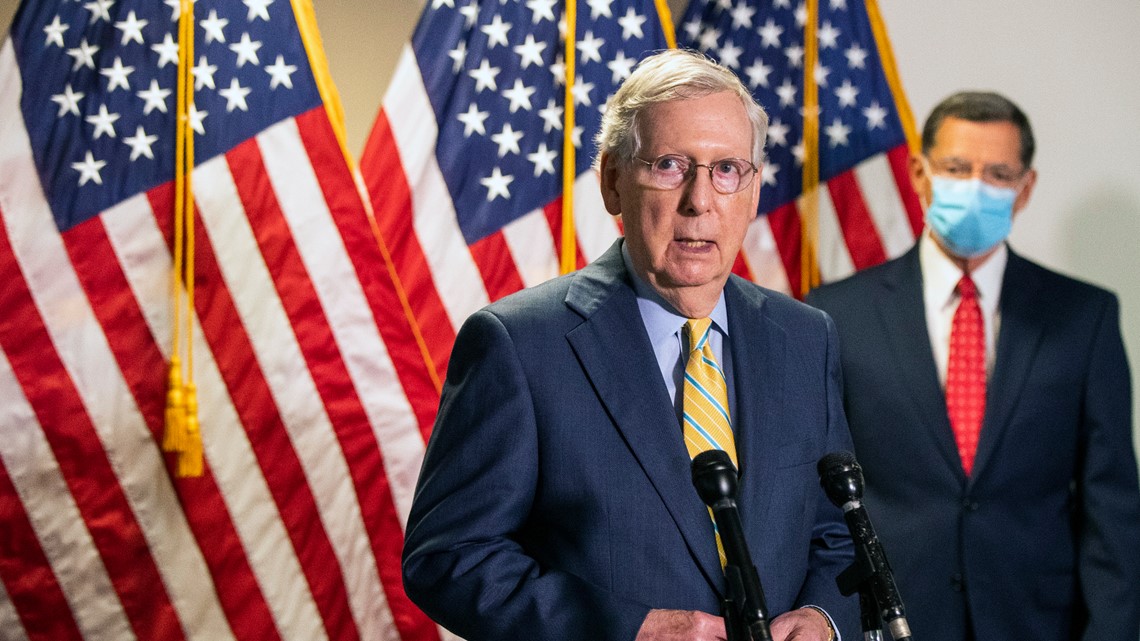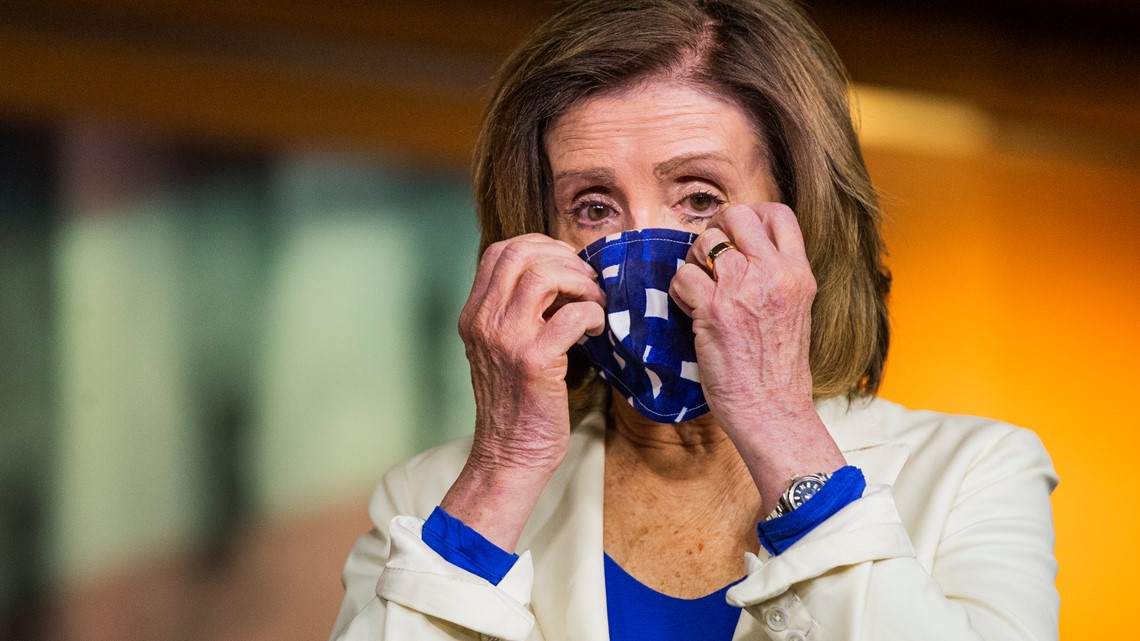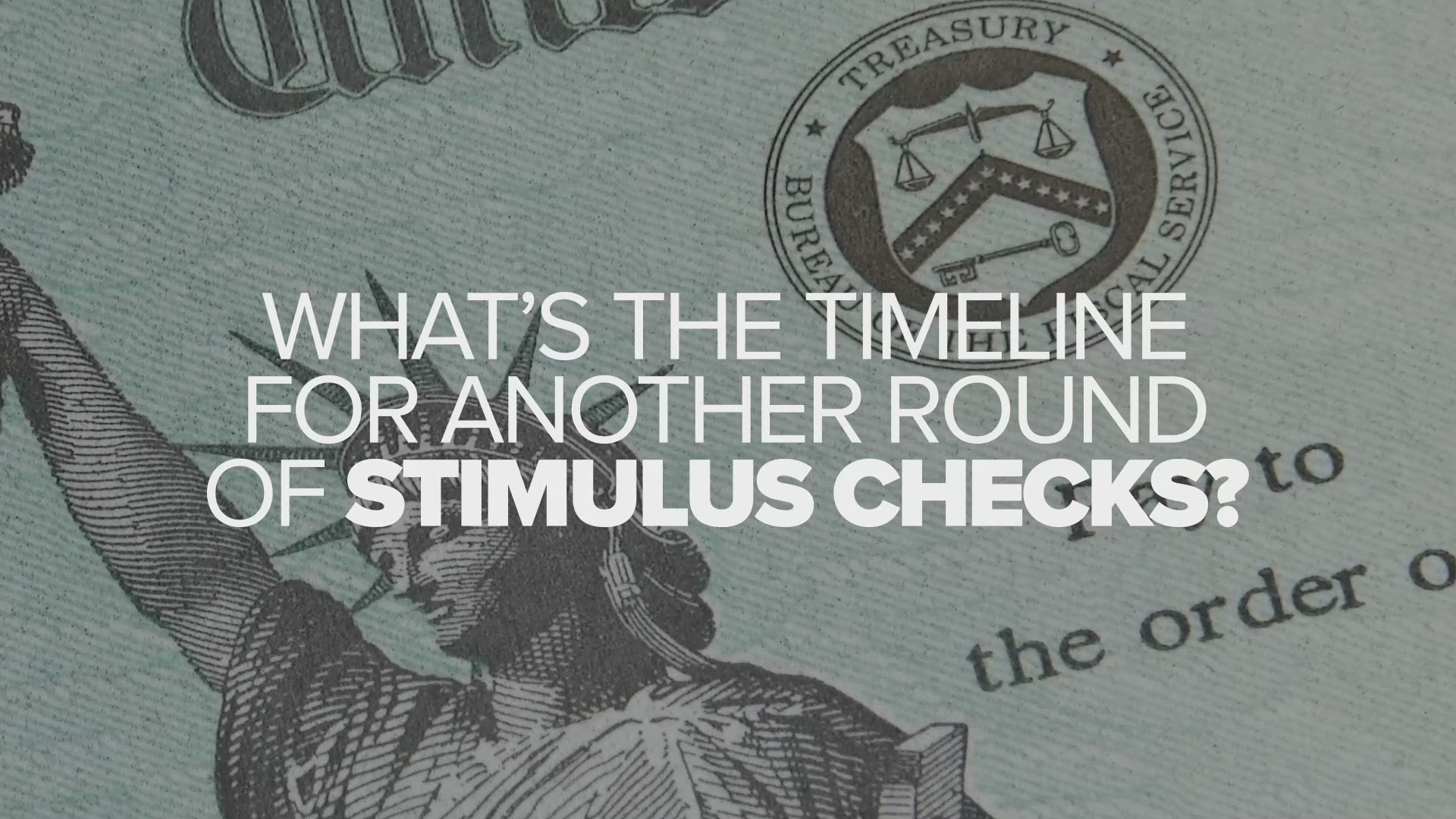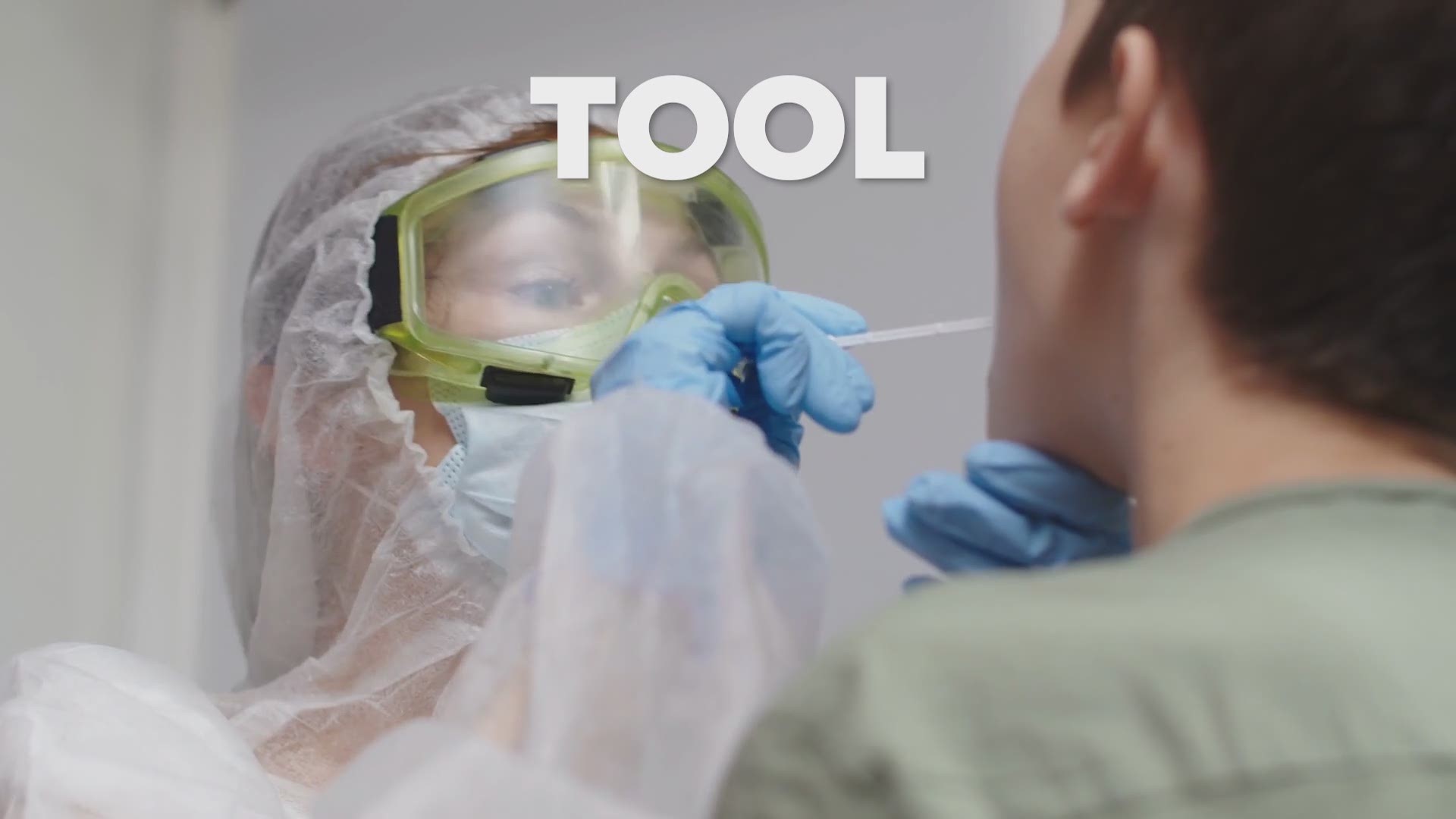WASHINGTON — As the number of coronavirus cases spike in parts of the country, even forcing some states to re-close certain businesses, many are wondering whether Congress will pass a second round of stimulus checks.
Congress seems poised to pass one more major economic relief bill, with Republican and Democratic leaders indicating more direct stimulus payments for Americans could be involved.
President Donald Trump and Treasury Secretary Steven Mnuchin have both said repeatedly that they support another round of economic impact payments.
Under the CARES Act, millions of Americans received checks up to $1,200 per adult, and an additional $500 for each eligible child, for individuals making less than $75,000 and couples making less than $150,000 annually.
The HEROES Act, which the House of Representatives passed in May, would have authorized another round of payments, but the Republican-controlled Senate deemed the $3 trillion proposal dead on arrival.
The HEALS Act is the Senate Republican proposal. It has a $1 trillion price tag that also offers another round of $1,200 payments as well as $500 for child and adult dependents alike. It also reduces the amount of additional unemployment Americans would receive from $600 to $200.
Both sides are now negotiating, but striking any agreement between Congress and President Donald Trump by the July 31 deadline for aid from the CARES Act will be daunting. Senate Majority Leader Mitch McConnell is also dealing with the fact that Republicans are deeply divided over the prospect of big government spending.
Below is a timeline with details on key dates for Congress and what one more economic stimulus package could look like. This story will be updated as new information becomes available and as the timeline changes for a possible second stimulus check.
What is the timeline for a second stimulus check?
August 18
Senate Republican leaders are preparing a slimmed-down coronavirus relief package of roughly $500 billion that will include extended payments for unemployed people and smaller businesses, Sen. Roy Blunt, R-Mo., said.
The bill does not include a renewal of the one-time direct payments of up to $1,200 for taxpayers and dependents that were part of early legislation aimed at providing relief to people as the economy slowed to a near halt. Senate Majority Leader Mitch McConnell said he'd favor continuing the aid to lower-income people “who have been hit the hardest by the pandemic.”
July 27
Senate Republicans introduced the HEALS Act. It would provide another round of $1,200 direct payments based on the same formula from the earlier aid bill. People making $75,000 or less would receive the full amount, with the benefit phased out for those earning above $99,000, or double for married couples filing joint taxes.
Unlike the CARES Act, the HEALS Act would provide that additional $500 to taxpayers with dependents of any age.
Under the GOP proposal, the jobless boost would be reduced to $200 a week for two months through September and phased out to a new system that ensures no more than 70% of an employee’s previous pay. States could request an additional two months, if needed, to make the transition.
It provides some $105 billion to schools and colleges, the K-12 funds tilted toward campuses that reopen with in-person learning. There's more money for virus testing, $15 billion for child care centers and benefits for businesses, including a fresh round of loans under the Paycheck Protection Program, tax breaks and a sweeping liability shield from COVID-19-related lawsuits.
But conservative Republicans quickly broke ranks, arguing the spending was too much and priorities misplaced. Half the Republican senators could vote against the bill, some warned, and their opposition leaves McConnell heading into negotiations with Pelosi without the full force of the Senate majority behind him.
July 20 - July 24
The U.S. Senate returned from a more than a two-week recess Monday with McConnell saying he will begin "socializing what we've been discussing with the administration over the last two weeks with our members."
Mnuchin recently told CNBC that "as soon as the Senate gets back, we're going to sit down on a bipartisan basis with the Republicans and the Democrats and it will be our priority to make sure between the 20th and the end of the month that we pass the next legislation."
Mnuchin and acting chief of staff Mark Meadows have plans to meet privately Tuesday with Pelosi and Senate Democratic leader Chuck Schumer do discuss a potential bill more in detail.


July 31
On July 31, the U.S. House is scheduled to begin a more than one month recess that would last until just after Labor Day.
House Speaker Nancy Pelosi said Tuesday she's "absolutely" willing to delay or cancel that recess in order to come to an agreement on additional economic relief for Americans.
"The timetable is the timetable of the American people needing their unemployment insurance, their direct payments, their assistance for rent and mortgage...forbearance," Pelosi told CNN. "We need it for states and localities to be able to pay their employees who are meeting the needs of their constituents."


Aug. 7
On the other side of the Capitol, McConnell has made it clear he is less willing to delay the Senate's planned Summer recess, which is scheduled to begin on Aug. 10 and last until Sept. 8. McConnell told reporters on June 30 that "we are going to stay on the schedule that I announced earlier in the year, which means we will not be here in August."
In that case, Congress will have just three weeks to discuss, negotiate and pass another stimulus package by Aug. 7, the last day the Senate is scheduled to be in session before its break.
Sept. 8 to Sept. 25
If Congress can't come to an agreement before Aug. 7, and if the Senate goes on its summer recess as planned, then this two-week period in mid-September would be the next shot lawmakers have at passing a coronavirus relief bill.
When could a second stimulus check be sent?
As of July 21, when a second stimulus check will be sent all depends on when legislation is approved.
House Minority Leader Kevin McCarthy told CNBC he expects legislation to be passed in the first week of August.
President Trump approved the CARES Act on March 27 and the first Economic Impact Payments started appearing in people's bank accounts about three weeks later, during the week of April 14.
However, because the IRS already did a lot of the set-up work during the first round of payments, there's a chance a second round of stimulus checks could be sent out faster.
That being said, nothing will be sent out until Congress comes to an agreement on a stimulus package. With the Senate just returning from recess on Monday, there's still a chance for the IRS to start issuing checks in August but the window for that is shrinking.
What could the second stimulus check look like?
When asked about a second stimulus check when visiting a hospital in his home state of Kentucky on July 6, McConnell suggested targeting those making $40,000 a year or less.
"I think the people who have been hit the hardest are people who make about $40,000 a year or less. Many of them work in the hospitality industry. So that could well be a part of it," McConnell said.
However, the Associated Press reported Tuesday that McConnell's economic package may include a fresh round of direct $1,200 cash payments to Americans below a certain income level, likely $75,000.
The Democrats' HEROES Act would have offered another $1,200 per person plus $1,200 per dependent, with a $6,000 cap per household.
There have also been a variety of other stimulus check ideas proposed by lawmakers since the pandemic begins. If a second check is approved, it could look like one of the above or be something completely different. We won't know for sure until the legislation is proposed and voted on.
What else could be in the next stimulus bill?
McConnell has said that any more economic relief packages must have liability protection to help protect hospitals, doctors, nurses, businesses and schools for the next five years.
"Nobody should have to face an epidemic of lawsuits," McConnell told reporters on July 13.
In addition to liability protection, McConnell told reporters in the oval office Monday that the theme of the upcoming bill will be "kids in school, jobs and health care."
Senate Democrats have proposed a $430 billion education stabilization plan. But the Republican leader has not said how much Congress is willing to spend, wary of high-dollar outlays that will run into resistance from GOP senators. Vice President Mike Pence assured governors on July 13 that talks are underway for education funds from Congress.
The package from McConnell, being crafted behind closed doors, is expected to include $105 billion to schools.
"This country wants its kids back in the classroom this fall learning, exploring, making friends, Their education depends on it," McConnell said from the Senate floor Tuesday. "This majority is preparing legislation that will send $105 billion so that educators have the resources they need to safely reopen."
The CARES Act included additional unemployment benefits for those who lost their job due to the pandemic. The program provided an additional $600 per week in Federal Pandemic Unemployment Compensation (FPUC). Without additional legislation, that program will expire on July 31.
McConnell's bill will likely replace the expiring unemployment benefits boost with a smaller amount. The cut in unemployment assistance is designed to ensure that jobless people do not receive a greater benefit than if they were working. Regular state benefits vary widely, and the measure would peg the federal bonus payment to a percentage of the state benefit.
"We're going to make sure that people are [incentivized] to go back to jobs, Mnuchin recently told CNBC. "We'll figure out an extension to it that works for companies and works for people who will still be unemployed."
Also during Monday's oval office meeting, Mnuchin announced the possibility of using tax credits to incentivize businesses to bring people back to work.
In addition, a bill could provide continued eviction protections. The original CARES Act provides a temporary moratorium on evictions for most residents of federally subsidized apartments, including those supported by HUD, USDA or Treasury for 120 days after enactment. That means the service would end Saturday, July 25, 2020.
Trump has also demanded including a payroll tax cut in the upcoming economic bill. The payroll tax is a 7.65% tax paid by employers and employees that funds Social Security and Medicare.
"I think it's very important thing is good, it's been proven to be successful," Trump told reporters in the oval office Monday. "It's a big saving for the people, tremendous saving and I think there's an incentive for companies to hire new workers back."
Easing the payroll tax is dividing Trump’s party. The tax is already being deferred for employers under the previous virus relief package. Supporters say cutting it now for employees would put money in people's pockets and stimulate the economy, but detractors warn it would do little for out-of-work Americans and add to the nation’s rising debt load. McConnell is straining to keep the bill’s total price tag at $1 trillion.
The Washington Post reports that the administration is considering a deferral rather a cut, which would keep the cost of the overall bill down. A deferral would require Americans to pay the tax cut at a later date.
The Associated Press contributed to this report.


